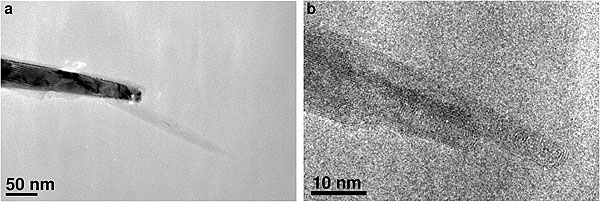Home > Press > Tiny Material, Big Risk
 |
| Images taken by a transmission electron microscope (TEM), of an individual carbon nanotube mounted on a tungsten tip. In a), the end of the tungsten tip (dark) and the complete nanotube (light) can be seen. Picture b) shows the apex of the nanotube under larger magnification. The apex has a radius of just 2.7 nanometers. Photo: Philips |
Abstract:
Slight modifications to nanomaterials can be the difference between medical marvel and medical hazard. The latest find by two UD researchers show possible damage to DNA.
Tiny Material, Big Risk
DAYTON, OH | Posted on February 14th, 2008Liming Dai, a University of Dayton chemical and materials engineering professor, and Yiling Hong, a UD assistant biology professor have made a breakthrough in determining the safety of microscopic carbon materials sometimes used for gene, drug or cancer therapies.
When they introduced carbon nanotubes into mouse embryonic stem cells, they found that carbon nanotubes could damage DNA.
"DNA is genetic material. If the DNA is mutated, the mutation could be passed on to future generations (offspring)," Hong said.
Dai said it's important to understand why certain nanomaterials are toxic and how to control their toxicity, because more people are being exposed to nanomaterials. Slight modifications to their structures or surfaces can be the difference between a medical marvel and medical hazard.
Nanomaterials, the family which includes carbon nanotubes, can be as much as 8,000 times smaller than a strand of hair. They already are used in cosmetics, stain-resistant fabric and ointments.
The next step is to identify ways to create safer carbon nanotubes through surface modification and examine how other nanomaterials work in the entire bodies of animals, according to Hong.
Lin Zhu and Dong Wook Chang, in UD's biology and chemical and materials engineering departments, respectively, also helped with the study. The American Chemical Society's Nano Letters published the group's findings in November.
Nanowerk said the study is the first of its kind evaluating the potential toxicity of a nanomaterial on the molecular level. DNA is at the molecular level, which is smaller than the cellular level.
In previous work with biocompatibility of other nanomaterials on the cellular level last year, Dai published findings that carbon nanodiamonds were safe. Dai performed that research with UD graduate student Amanda Schrand, Saber Hussain of the Air Force Research Lab and Eiji Osawa of Japan's NanoCarbon Institute Ltd. They received support from Japan's New Energy and Industrial Technology Development Organization, the Oak Ridge Institute for Science and Education, the Dayton Area Graduate Studies Institute and the National Science Foundation.
####
About University of Dayton
UD ranks second in the nation for industry-and government-funded materials research and is the largest private university in Ohio.
For more information, please click here
Contacts:
Shawn Robinson
937-229-3391
Copyright © University of Dayton
If you have a comment, please Contact us.Issuers of news releases, not 7th Wave, Inc. or Nanotechnology Now, are solely responsible for the accuracy of the content.
| Related News Press |
News and information
![]() Researchers develop molecular qubits that communicate at telecom frequencies October 3rd, 2025
Researchers develop molecular qubits that communicate at telecom frequencies October 3rd, 2025
![]() Next-generation quantum communication October 3rd, 2025
Next-generation quantum communication October 3rd, 2025
![]() "Nanoreactor" cage uses visible light for catalytic and ultra-selective cross-cycloadditions October 3rd, 2025
"Nanoreactor" cage uses visible light for catalytic and ultra-selective cross-cycloadditions October 3rd, 2025
Discoveries
![]() Researchers develop molecular qubits that communicate at telecom frequencies October 3rd, 2025
Researchers develop molecular qubits that communicate at telecom frequencies October 3rd, 2025
![]() Next-generation quantum communication October 3rd, 2025
Next-generation quantum communication October 3rd, 2025
![]() "Nanoreactor" cage uses visible light for catalytic and ultra-selective cross-cycloadditions October 3rd, 2025
"Nanoreactor" cage uses visible light for catalytic and ultra-selective cross-cycloadditions October 3rd, 2025
Announcements
![]() Rice membrane extracts lithium from brines with greater speed, less waste October 3rd, 2025
Rice membrane extracts lithium from brines with greater speed, less waste October 3rd, 2025
![]() Researchers develop molecular qubits that communicate at telecom frequencies October 3rd, 2025
Researchers develop molecular qubits that communicate at telecom frequencies October 3rd, 2025
![]() Next-generation quantum communication October 3rd, 2025
Next-generation quantum communication October 3rd, 2025
![]() "Nanoreactor" cage uses visible light for catalytic and ultra-selective cross-cycloadditions October 3rd, 2025
"Nanoreactor" cage uses visible light for catalytic and ultra-selective cross-cycloadditions October 3rd, 2025
Safety-Nanoparticles/Risk management
![]() Onion-like nanoparticles found in aircraft exhaust May 14th, 2025
Onion-like nanoparticles found in aircraft exhaust May 14th, 2025
![]() Closing the gaps — MXene-coating filters can enhance performance and reusability February 28th, 2025
Closing the gaps — MXene-coating filters can enhance performance and reusability February 28th, 2025
|
|
||
|
|
||
| The latest news from around the world, FREE | ||
|
|
||
|
|
||
| Premium Products | ||
|
|
||
|
Only the news you want to read!
Learn More |
||
|
|
||
|
Full-service, expert consulting
Learn More |
||
|
|
||








